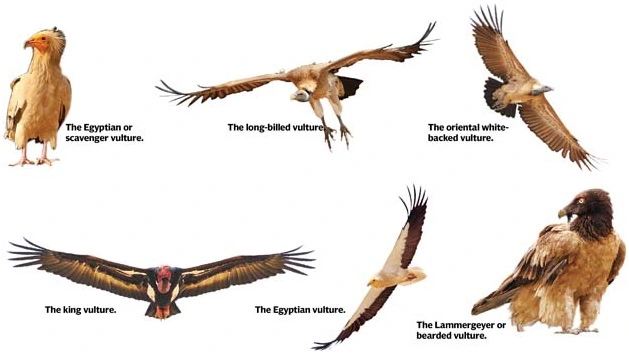Captive-bred vultures take wing in forest expanses
Context:
At the Jatayu Conservation Breeding Center in Pinjore, Haryana, eight highly endangered oriental white-backed captive-bred vultures were released into the wild for the first time in India in 2020.
About oriental white-backed vultures
- South and Southeast Asia are home to the Old World vulture known as the white-rumped vulture (Gyps bengalensis).
- Due to a drastic population reduction, it has been designated as Critically Endangered on the IUCN Red List since 2000.
- Diclofenac toxicity is the main cause of the deterioration. Diclofenac-treated livestock corpses are eaten by vultures, which causes kidney failure in the birds.
- The white-rumped vulture was the most common big bird of prey in the world in the 1980s, with an estimated population of several million.
- But by 2021, there were just 6,000 or so adults in the world who were of legal age.
- The European griffon vulture (Gyps fulvus), which is closely related to the white-rumped vulture.
- The population of critically endangered vulture species, including the white-rumped vulture, is being protected and restored via conservation initiatives.
- The main goal of these initiatives is to lessen vulture exposure to diclofenac and other dangerous veterinary medications.
- By disposing of animal carcasses, vultures play a critical role in scavenging and avoiding the spread of disease, which is why conservationists try to increase public awareness of their significance in the environment.

Where can we find the presence of the vultures in India?
- Historical Abundance: In the Gangetic plains of India, the white-rumped vulture (Gyps bengalensis) was previously widely distributed, and it was frequently spotted breeding on avenue trees in the area’s major cities.
- Naturalist observations: According to renowned ornithologists Hugh Whistler and T.C. Jerdon, the white-rumped vulture is the most prevalent in India. They were extremely common throughout the nation, including Calcutta, and were especially numerous surrounding the Towers of Silence in Bombay.
Why was there a decline?
- Early Signs of Decline: By 1990, the species had already started to become scarce in some parts of Andhra Pradesh, India. Residents’ vulture-hunting for food was one of the causes. The same year, a cyclone caused numerous cattle deaths, yet no vultures were discovered around the bodies.
- Population Decline: The white-rumped vulture, together with the Indian vulture and slender-billed vulture, has had a 99% population decline in India and neighbouring countries since the early 1990s.
- Diclofenac Poisoning: Diclofenac is a non-steroidal anti-inflammatory drug (NSAID) used in veterinary medicine that has been extensively blamed for the decline. Diclofenac residues are found in the corpses of cattle that have had treatment with it. These infected carcasses cause kidney damage in vultures that eat them.
What was the recent improvement in their situation?
- Initial Release: From the Jatayu Conservation Breeding Center in Pinjore, Haryana, eight critically endangered oriental white-backed vultures were released into the wild for the first time in India in 2020.
- Survival and Nesting: Five of the vultures that were released have survived over three years later, and two of them have successfully nested in the wild environment of the Shivalik range in the Himalayan foothills. This is a noteworthy accomplishment and a promising development for the re-induction initiative.
- Conservation Importance: The success of the vulture release and nesting has been lauded by wildlife enthusiasts and ornithologists. Vultures have been under threat of extinction since the 1990s, and the survival and nesting of these released birds indicate progress in vulture conservation efforts.
- No Mortality: The good news is that there have been no reports of deaths among the released vultures due to NSAIDs. This indicates the establishment of vulture-safe zones and signifies progress in mitigating the threat posed by these drugs.
- Conservation Breeding Program: To address the declining vulture population, the Bombay Natural History Society (BNHS) and the Royal Society for the Protection of Birds (RSPB) have been managing four Jatayu conservation breeding centres across the country in partnership with state governments (Haryana, Madhya Pradesh, West Bengal, and Assam). The program has successfully bred more than 700 vultures in captivity since 2004.
- Expansion of Vulture-Safe Zones: Inspired by the success, the BNHS has initiated the construction of soft release centres in various locations, including Madhya Pradesh, Assam, Rajasthan, and three tiger reserves in Maharashtra. These areas are considered suitable for releasing captive-bred vultures due to their lack of human and livestock presence and the availability of prey free from NSAIDs.
- Ban on NSAIDs: Conservationists believe that banning NSAIDs toxic to vultures, such as aceclofenac and ketoprofen, is crucial for vulture conservation. The Drugs Technical Advisory Board (DTAB), a government body, has recommended banning the use, sale, and manufacture of these veterinary drugs for animal use.





